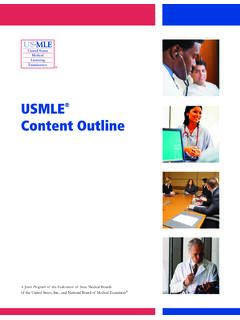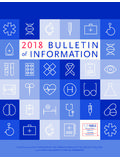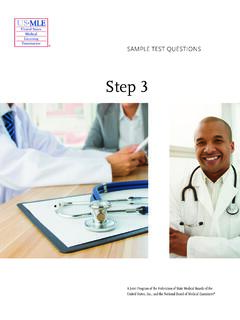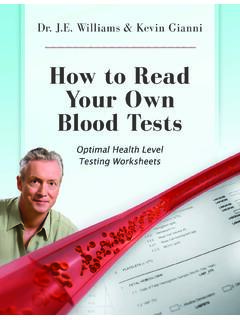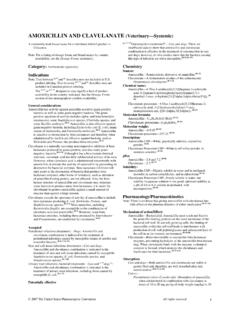Transcription of Step 1 - USMLE
1 SAMPLE TEST QUESTIONS. Step 1. A Joint Program of the Federation of State Medical Boards of the United States, Inc., and National Board of Medical Examiners . This booklet was updated February 2021. For Public Release Copyright 2021 by the Federation of State Medical Boards of the United States, Inc. (FSMB), and National Board of Medical Examiners (NBME ). All rights reserved. Printed in the United States of America. The United States Medical Licensing Examination ( USMLE ) is a joint program of the FSMB and NBME. 1. CONTENTS. USMLE Step 1 Test Question Formats 3.
2 Introduction to USMLE Step 1 Sample Test Questions .. 4. USMLE Laboratory Values .. 5. USMLE Step 1 Sample Test Questions . 8. Answer Form for USMLE Step 1 Sample Test Questions . 48. Answer Key for USMLE Step 1 Sample Test Questions . 49. 2. USMLE STEP 1 TEST QUESTION FORMATS. Single-Item Questions A single patient-centered vignette is associated with one question followed by four or more response options. The response options are lettered (A, B, C, D, E). A portion of the questions require interpretation of graphic or pictorial materials. You are required to select the best answer to the question.
3 Other options may be partially correct, but there is only ONE BEST answer. This is the traditional, most frequently used multiple- choice question format on the examination. Strategies for Answering Single One-Best-Answer Test Questions The following are strategies for answering one-best-answer items: Read each patient vignette and question carefully. It is important to understand what is being asked. Try to generate an answer and then look for it in the response option list. Alternatively, read each response option carefully, eliminating those that are clearly incorrect.
4 Of the remaining options, select the one that is most correct. If unsure about an answer, it is better to guess since unanswered questions are automatically counted as wrong answers. Example Item A 32-year-old woman with type 1 diabetes mellitus has had progressive renal failure during the past 2 years. She has not yet started dialysis. Examination shows no abnormalities. Her hemoglobin concentration is 9 g/dL, hematocrit is 28%, and mean corpuscular volume is 94 m3. A blood smear shows normochromic, normocytic cells. Which of the following is the most likely cause?
5 (A) Acute blood loss (F) Microangiopathic hemolysis (B) Chronic lymphocytic leukemia (G) Polycythemia vera (C) Erythrocyte enzyme deficiency (H) Sickle cell disease (D) Erythropoietin deficiency (I) Sideroblastic anemia (E) Immunohemolysis (J) -Thalassemia trait (Answer: D). NOTE: Some item types that appear on the Step 1 examination are NOT depicted in the sample items provided in this booklet, eg, items with multimedia features, such as audio. Also, when additional item formats are added to the exam, notice will be provided at the USMLE website: You must monitor the website to stay informed about the types of items that occur in the exam, and you must practice with the downloadable sample test items available on the USMLE website to be fully prepared for the examination.
6 3. INTRODUCTION TO USMLE STEP 1 SAMPLE TEST QUESTIONS. The following pages include 119 sample test questions. Most of these questions are the same as those you can install on your computer from the USMLE website. Please note that reviewing the sample questions as they appear on pages 8 47 is not a substitute for practicing with the test software. You should download and run the Step 1 tutorial and practice test items that are provided on the USMLE website well before your test date. The sample materials available on the USMLE website include an additional item with associated audio findings that does not appear in this booklet.
7 You should become familiar with this item format that will be used in the actual examination. Although the sample questions exemplify content on the Step 1 examination overall, they may not reflect the content coverage on individual examinations. In the actual examination, questions will be presented in random order; they will not be grouped according to specific content. The questions will be presented one at a time in a format designed for easy on-screen reading, including use of the USMLE Laboratory Values table (included here on pages 5 7) and some pictorials.
8 Photographs, charts, and x-rays in this booklet are not of the same quality as the pictorials used in the actual examination. In addition, you will be able to adjust the brightness and contrast of pictorials on the computer screen. To take the following sample test questions as they would be timed in the actual examination, you should allow a maximum of 1 hour for each 40-item block, and a maximum of 58 minutes, 30 seconds, for the 39-item block, for a total of 2 hours, 58 minutes, 30 seconds. Please note that the third block has 39 items instead of 40 because the multimedia item has been removed, and the recommended time to complete the block has been adjusted accordingly.
9 Please be aware that most examinees perceive the time pressure to be greater during an actual examination. All examinees are strongly encouraged to practice with the downloadable version to become familiar with all item formats and exam timing. An answer form for recording answers is provided on page 48. An answer key is provided on page 49. In the actual examination, answers will be selected on the screen; no answer form will be provided. 4. USMLE Laboratory Values Reference Range SI Reference Intervals SERUM. General Chemistry: Electrolytes Sodium (Na+) 136 146 mEq/L 136 146 mmol/L.
10 Potassium (K+) mEq/L mmol/L. Chloride (Cl ) 95 105 mEq/L 95 105 mmol/L. Bicarbonate (HCO3 ) 22 28 mEq/L 22 28 mmol/L. Urea nitrogen 7 18 mg/dL mmol/L. Creatinine mg/dL 53 106 mol/L. Glucose Fasting: 70 100 mg/dL mmol/L. Random, non-fasting: <140 mg/dL < mmol/L. Calcium mg/dL mmol/L. Magnesium (Mg2+) mg/dL mmol/L. Phosphorus (inorganic) mg/dL mmol/L. Hepatic: Alanine aminotransferase (ALT) 10 40 U/L 10 40 U/L. Aspartate aminotransferase (AST) 12 38 U/L 12 38 U/L. Alkaline phosphatase 25 100 U/L 25 100 U/L. Amylase 25 125 U/L 25 125 U/L. Bilirubin, Total // Direct mg/dL // mg/dL 2 17 mol/L // 0 5 mol/L.
